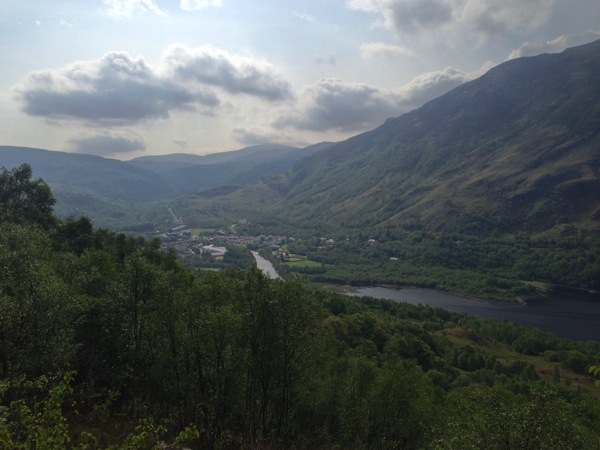
You leave Kinlochleven by a road and then trail that ascends almost as steeply as the Devil's Staircase to a ridge-line where an old Military Road remains. This view of Loch Leven is still 100 meters below that point but it's not a bad place to catch your breath as you have been climbing steadily through birch forest until this point.
Our last day hiking the West Highland Way has come to an end and in several ways this 16 mile day encapsulates much of what the Way has been like. Once again the wether gods smiled upon us and we started the hike from Kinlochleven under pretty clear and warm skies. The temperature would rise easily to 70 degrees and I am confident this was the warmest day of our 8 day journey. There was a breeze most of the day but while brisk at times it was anything but bothersome especially as we hiked the several miles of Military Road through the Lairigmor (the Great Pass). That's just part of what I meant by the day encapsulating the whole trail. We began with a walk through wooded park-like terrain as we left the confines of Kinlochleven. From there we hiked up a steep, though nowhere as steep as the Devil's Staircase, trail through birch woods to a ridge-line that looks down on Loch Leven some 250 meters below. Then it is onto the latest of the series of old military roads and start heading north west (more west early on with the wind at our backs and then turning northernly and still having a good deal of wind at our backs). The military road is wide, hard packed dirt and stone, and after several miles foot tiring. The going is technically easy but your feet ache for the softer tread-way of a mountain trail through forest where the dirt and leaf litter form a kinder path. We walked easily through Lairgmor admiring to open rolling hills with mountains so near that they seemed bigger than they actually are. It's a remote place but still some people have elected, well once did, to live here. We leapfrogged a group of fellow hikers at a rhine of a stone cottage where they were taking a break. While water is plentiful and I expect sheep could find plenty to graze even here it is a looney spot and no doubt a hard place to live. When we crossed one of the numerous streams to join a trail that ran through hills dotted with grazing sheep we breathed sighs of relief because the treadway had changed to a softer solid dirt. Suddenly it seemed a bit less lonely.
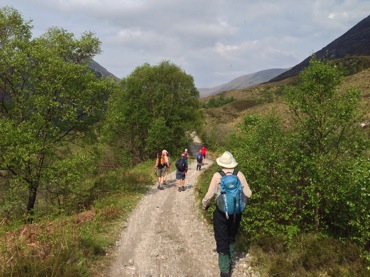
We start our walk along the old Military Road through the Lairigmor (Great Pass). Soon the trees will vanish and we will be treated to expanses of rolling hills that quickly turn into greater hills and mountains of pretty barren land.
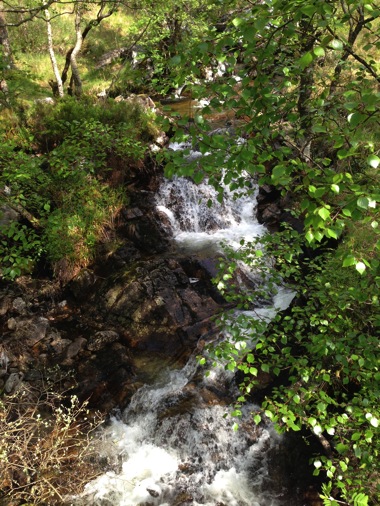
One of the many waterfalls we would pass. Maybe not as numerous as the pour-offs we strode by frequently when hiking the woods road above Loch Lomond on day 3 on our way to Ardlui but many streams would be forded as we trod the Military Road today.
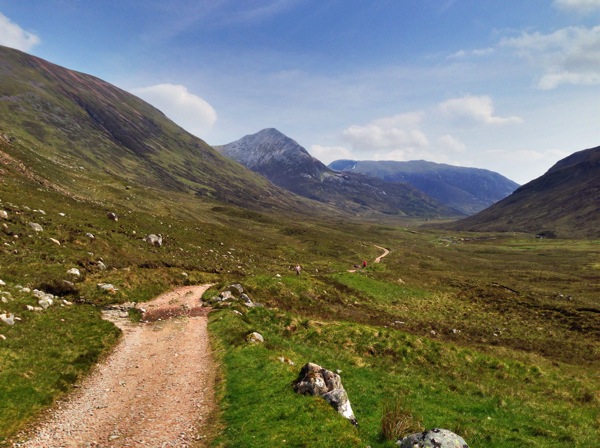
We had a late-morning snack near here. This view looks back from whence we came as as you can see we have been climbing a bit. The grade is gentle and the walking generally comfortable even though the path is rather hard. The land is bounded by tall hills and though there is grass here it's pretty empty of growth.
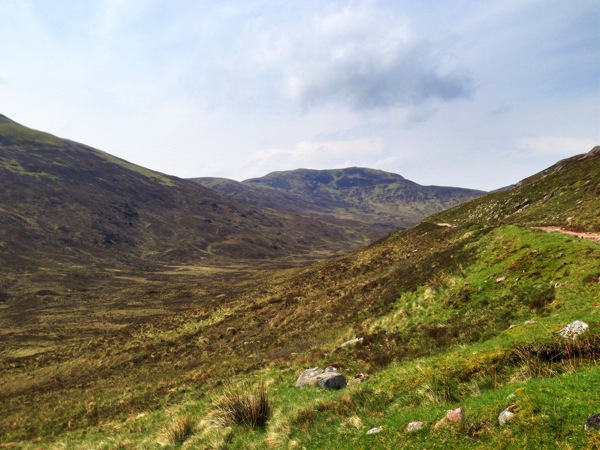
Looking to where we will be heading (more or less) near the same spot as the previous picture. Soon we will pas by an old stone cottage that has fallen into ruin. Why anyone would have settled up here to do sheep farming (I assume) is a bit of a mystery to me. This is not exactly a friendly spot with meager flora, plenty of wind, and lots of exposed land. Water is plentiful and I suppose if you want to be far from neighbors this is a good place.
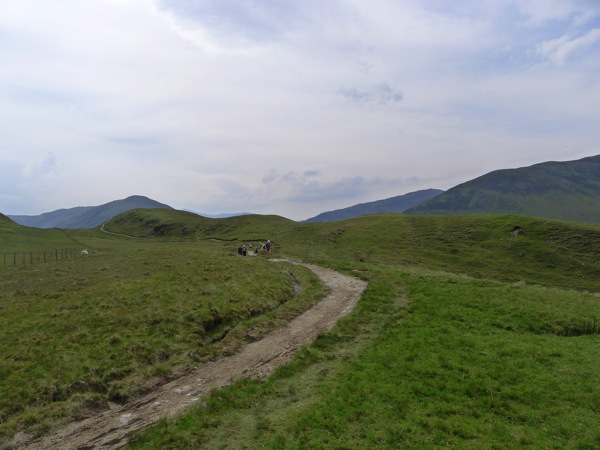
After just about 7 miles of the old Military Road we would reach a small woods where we settled down for lunch (about 13:00). Other people passed us by as we ate (we had leapfrogged them earlier) as we were all on our way to Fort William. Now we're on a small path that is winding its way through these fairly grassy hills that are home to grazing sheep. It's a much nicer section of trail for the feet to trod - nowhere near as hard.
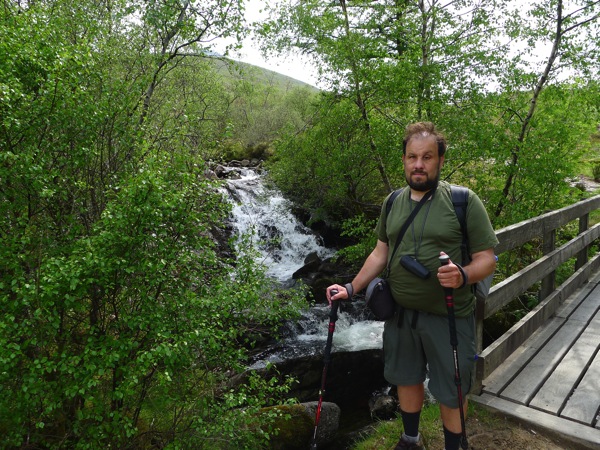
Soon after this point we enter forest plantations. This starts out wonderful with lovely well grown forest to walk through but after we descend to another bridge and water crossing (descending pretty much the entire time) we come out on a truly ugly bit of land full of gnarly stumps and logs. We'd have our afternoon snack on a hill above that mess and just a little ways south of the woods road and Dun Deardail Fort (an Iron Age fort) which you may just be able to see through the trees if you were in the right place to look (not this picture which is miles south and the last I took before reaching the Original Way End).
As you might expect the views along the 6 odd miles of military road were quite good. Mountains rise a couple thousand feet above us and in time you got very good views of the snow capped Ben Nevis which is the highest mountain in the United Kingdom standing a bit over 4,400 feet. But we would also be treated to some wonderful forest walking later in the day. Passing through the dense pine forest, again softer trail, was a real treat. It's too bad that when we left the far side of the pine forest we entered a sizable area devoid of trees land strewn with left-behind stumps and logs. The wreckage of a logging operation. Far less pretty than the huge water pipes we could kind of ignore yesterday.
Eventually we would leave the logging area for a forest road that would take us past a distant Iron Age fort called Dun Deardail, (barely visible) and down towards Fort William. A diversion, clearly well made but just as clearly needing switchbacks as it plummeted down the mountainside to rejoin the forest road. That road would take us to a paved road which would after about 4 miles take us past first the visitor center that I think supports Ben Nevis and then, oh so much later though likely less than 45 minutes walk, into Fort William. Not a pleasant walk really; just putting one foot down after the other and watching the traffic zip on by.
We paused at the original end of the West Highland Way for some pictures and then trudged through town (so many shops seemed closed) to where the trail really ends. They moved the end to force hikers to go through town but I think that mercenary decision has not been that popular and it seems odd if you aren't going to have shops open even (it was just after 17:00 by this time). We had experienced much of everything the trail had to offer today including a tiny splash of rain as we got to the Visitor Center (hardly worth mentioning).

The original end of the West Highland Way. They decided to move the current end another mile and a bit into the heart of Fort William. Perhaps they hoped people would stop and buy more goods. Personally I think this is a fine endpoint and that last mile just adds to the drag of the last 3 or so which you trod on paved road from just before the visitor center that supports Ben Nevis to the trail's end. Before that point you are walking a curving forestry road (with one helluva diversion that plummets down new well-made trail for some 400 meters).
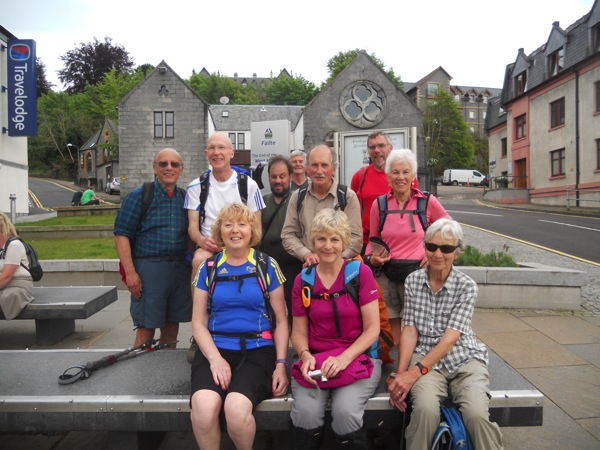
Our group, all but two, at the official end of the West Highland Way.
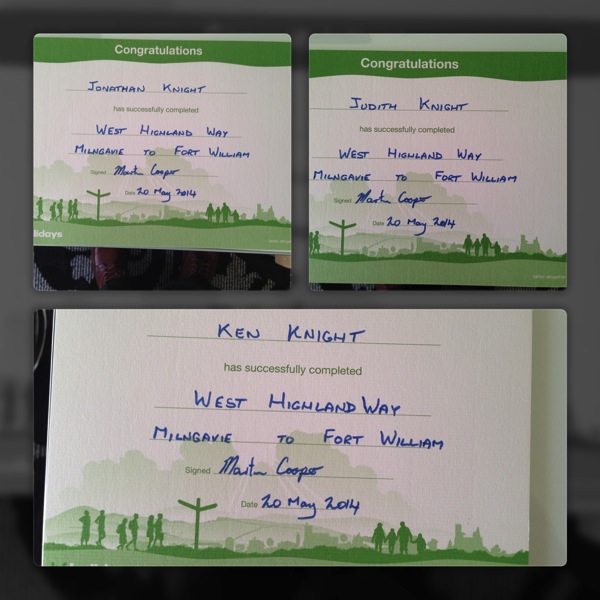
We Are Certified
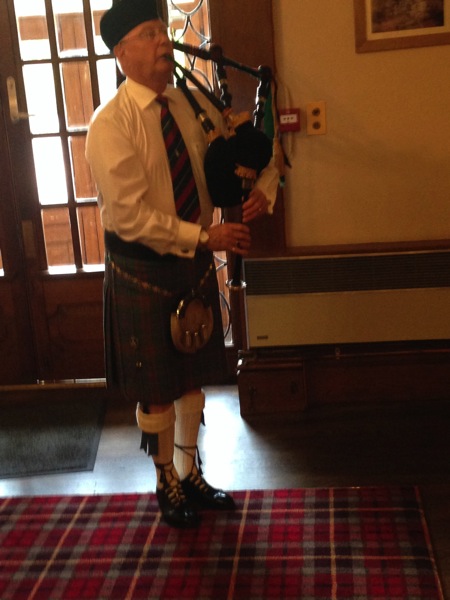
John the Piper playing us into our last dinner with the group.
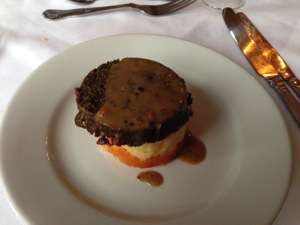
The famed and fabled haggis of Scotland. Quite tasty with tatties (potatoes) and jeeps (a yellow turnip-like plant).
We have completed the West Highland Way and are all quite happy. Ending the day at the hotel with John the Piper piping in the Haggis was an added special treat and something I don't think we will soon forget.
All 17 photos for day 8 (at much greater size) can be viewed in this Flickr photo album.
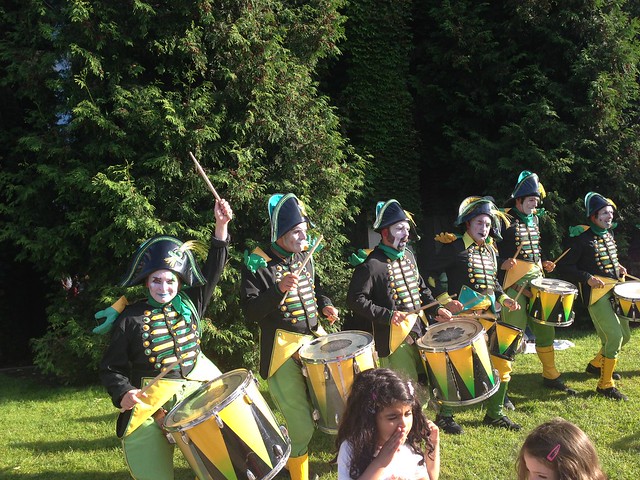
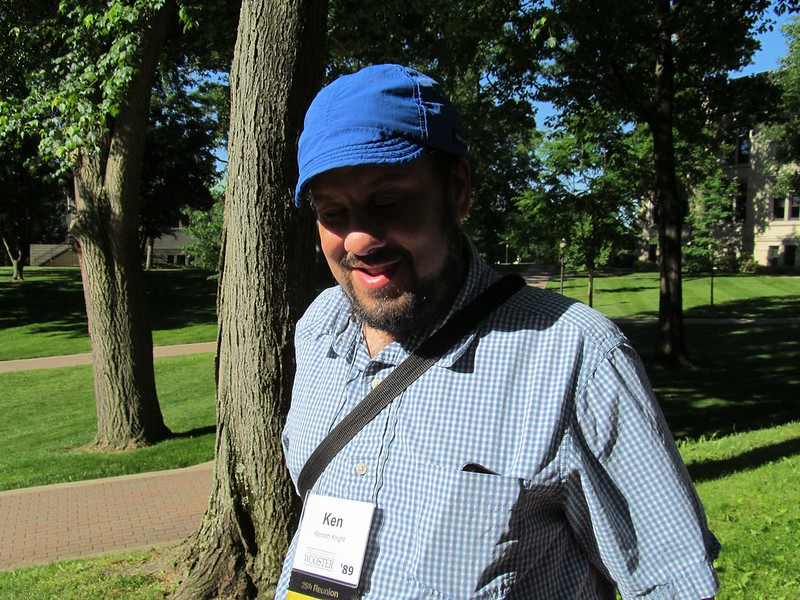
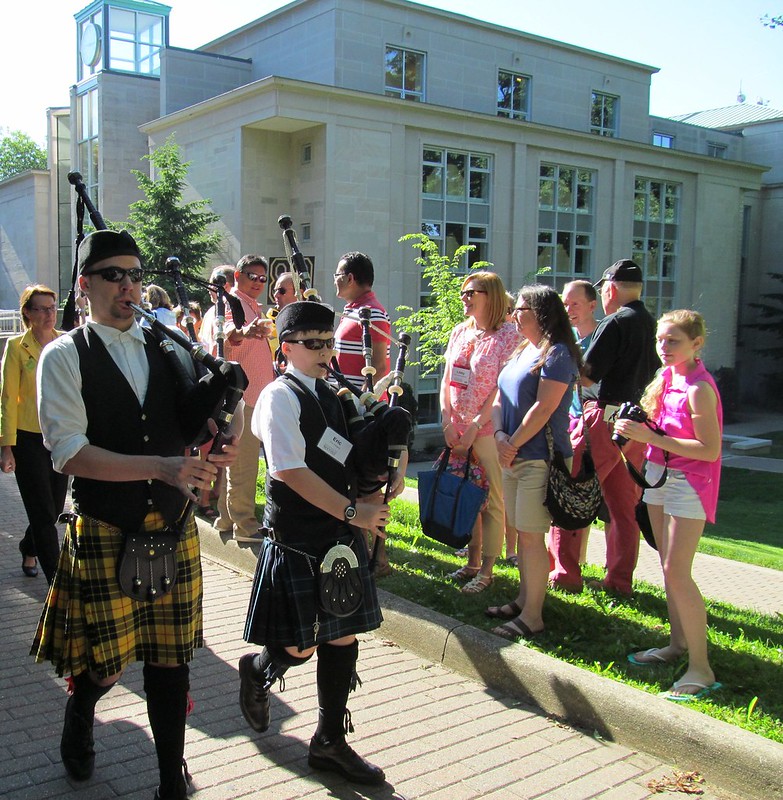
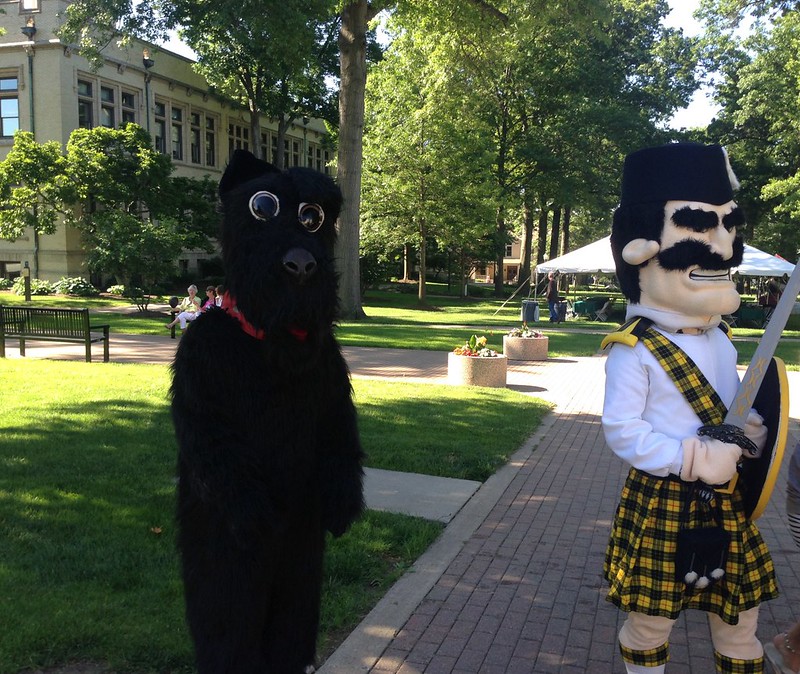
 One of the many waterfalls we would pass. Maybe not as numerous as the pour-offs we strode by frequently when hiking the woods road above Loch Lomond on day 3 on our way to Ardlui but many streams would be forded as we trod the Military Road today.
One of the many waterfalls we would pass. Maybe not as numerous as the pour-offs we strode by frequently when hiking the woods road above Loch Lomond on day 3 on our way to Ardlui but many streams would be forded as we trod the Military Road today. Our group, all but two, at the official end of the West Highland Way.
Our group, all but two, at the official end of the West Highland Way. John the Piper playing us into our last dinner with the group.
John the Piper playing us into our last dinner with the group. 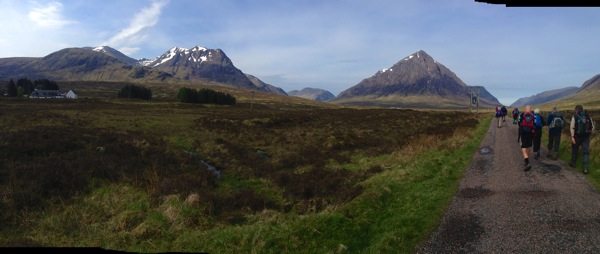 We leaves Kings House Hotel (sometimes spelled "Kingshouse") heading northwest on a track that is sadly not far from the A82. It's easy walking with a few streams to cross for the next 3 miles to the foot of the Devil's Staircase.
We leaves Kings House Hotel (sometimes spelled "Kingshouse") heading northwest on a track that is sadly not far from the A82. It's easy walking with a few streams to cross for the next 3 miles to the foot of the Devil's Staircase.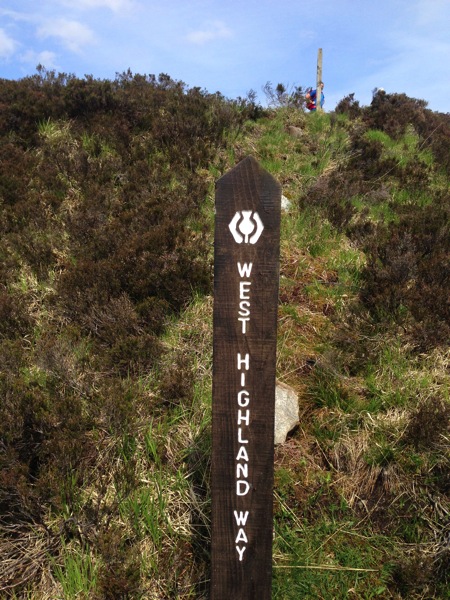 Signs of progress. This is the type of marker you are likely to find on the Way. I never saw anything akin to a trail blaze but except when crossing a road (or following a paved road) you really didn't have to many choices what route to follow. At the top of this hill we would pause for our elevenses before making the ascent of some 800 feet over just over one mile to the top of Devil's Staircase.
Signs of progress. This is the type of marker you are likely to find on the Way. I never saw anything akin to a trail blaze but except when crossing a road (or following a paved road) you really didn't have to many choices what route to follow. At the top of this hill we would pause for our elevenses before making the ascent of some 800 feet over just over one mile to the top of Devil's Staircase.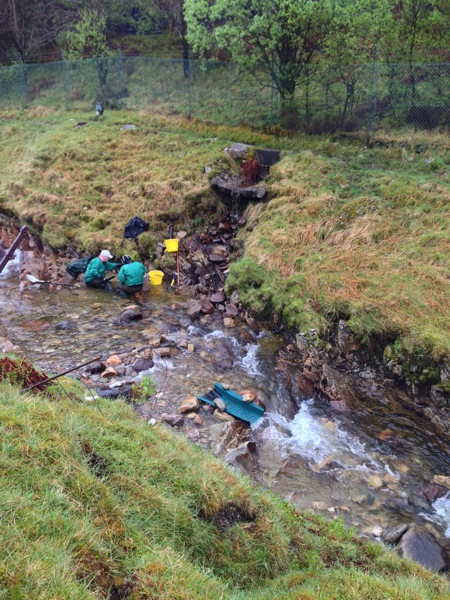 This is something I have not seen before. It's cooler today than it has been, probably not much more than 50 degrees F and I expect the stream is hardly warm but that isn't stopping these fellows from doing what they're doing: panning for gold. I've no idea how much gold they can gather but I suspect it's probably a tiny amount measured in grams. I think they must do it for reasons other than monetary reward rather like the reasons people do catch-and-release fishing hour after hour standing in a cold river. Their must be something about the work itself that is satisfying though I'm not quite sure what that is.
This is something I have not seen before. It's cooler today than it has been, probably not much more than 50 degrees F and I expect the stream is hardly warm but that isn't stopping these fellows from doing what they're doing: panning for gold. I've no idea how much gold they can gather but I suspect it's probably a tiny amount measured in grams. I think they must do it for reasons other than monetary reward rather like the reasons people do catch-and-release fishing hour after hour standing in a cold river. Their must be something about the work itself that is satisfying though I'm not quite sure what that is.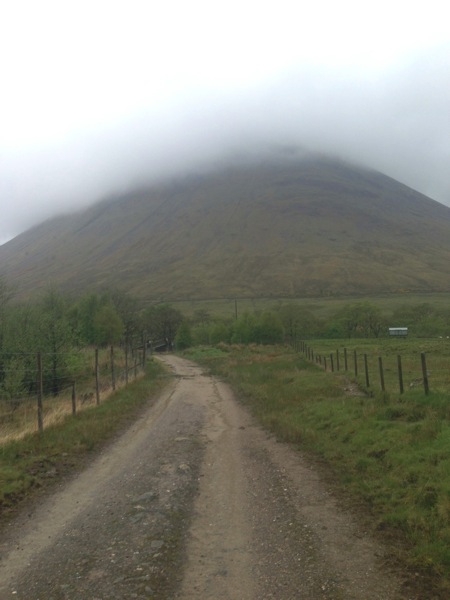 Misty Mountain
Misty Mountain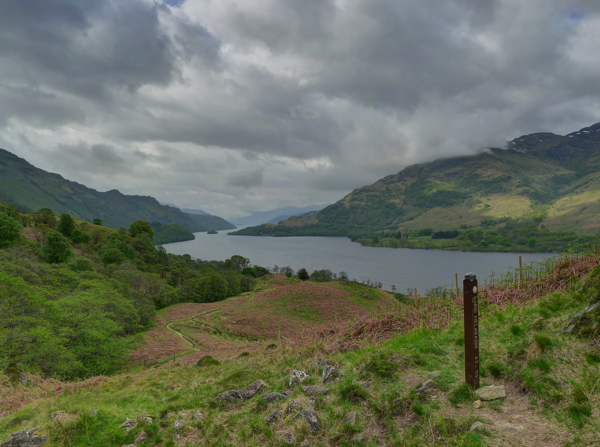 OK, so that wasn't the last view before but this one truly i the lsat view northbound hikers will get of the loch and it makes a fine first view for people heading south.
OK, so that wasn't the last view before but this one truly i the lsat view northbound hikers will get of the loch and it makes a fine first view for people heading south.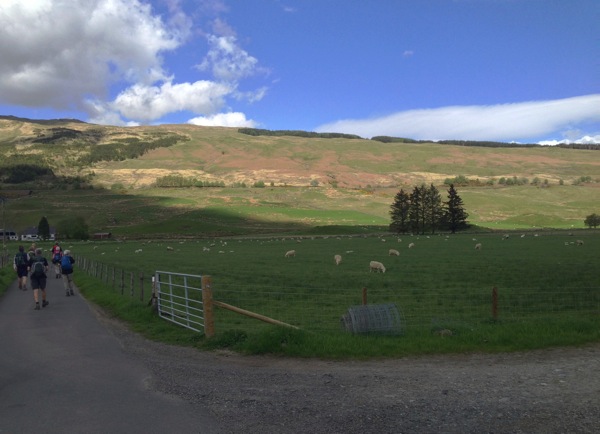 The people running this estate, Kirkton Farm I believe, are attempting to keep alive the long standing practices of highland sheep farming. It really isn't economically viable, or at least not that viable these days, from what I gathered. I guess the market for lamb, mutton, and wool isn't what it once was but I hope they are making a good go of it. The walking here is on estate roads and thus easy.
The people running this estate, Kirkton Farm I believe, are attempting to keep alive the long standing practices of highland sheep farming. It really isn't economically viable, or at least not that viable these days, from what I gathered. I guess the market for lamb, mutton, and wool isn't what it once was but I hope they are making a good go of it. The walking here is on estate roads and thus easy.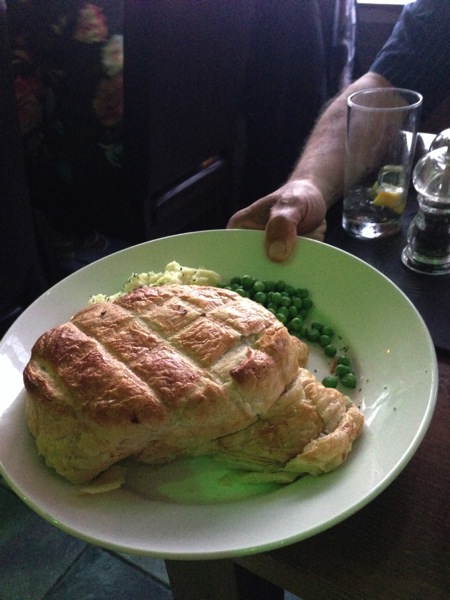 The portions at the restaurant in the Ardlui hotel may not be the tastiest but they are big. I'm not sure what this was called now but it's a bit like a pasty though the dough is flakier and lacks the outer ridge.
The portions at the restaurant in the Ardlui hotel may not be the tastiest but they are big. I'm not sure what this was called now but it's a bit like a pasty though the dough is flakier and lacks the outer ridge. 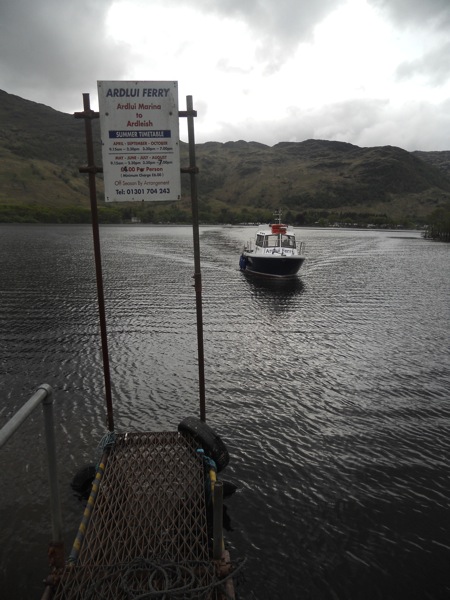 Perhaps 10 minutes earlier Steve hoisted the large orange ball on its flagpole to signal the ferry to come fetch us. At the time I didn't realize what that loud squeaking sound was but that was what it had to be. The ride doesn't take too long though I do wonder how rough the water is allowed to get before the ferry ceases to make the half-mile crossing.
Perhaps 10 minutes earlier Steve hoisted the large orange ball on its flagpole to signal the ferry to come fetch us. At the time I didn't realize what that loud squeaking sound was but that was what it had to be. The ride doesn't take too long though I do wonder how rough the water is allowed to get before the ferry ceases to make the half-mile crossing. We've been walking hard dirt and macadam roads pretty much all the way to this point marking our first view of Loch Lomond which is I believe the largest loch in Scotland. The loch will vanish from view as we continue to follow dirt road that turns into something more like a wide dirt trail winding through rolling valleys and a bit of woods before climbing Conic Hill.
We've been walking hard dirt and macadam roads pretty much all the way to this point marking our first view of Loch Lomond which is I believe the largest loch in Scotland. The loch will vanish from view as we continue to follow dirt road that turns into something more like a wide dirt trail winding through rolling valleys and a bit of woods before climbing Conic Hill.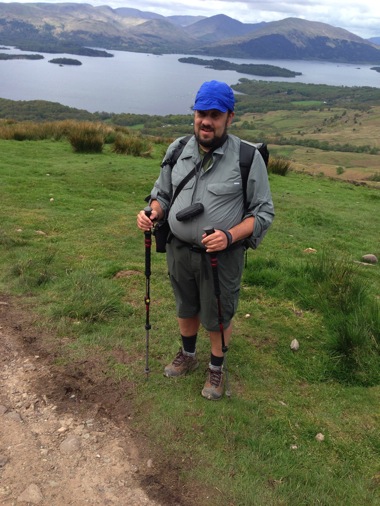 You can't really tell that Loch Lomond is nearly 300 meters below. I am standing just below a very windy summit of Conic Hill. It's windy enough here and I elected not to see the top of the hill. Perhaps had I been alone, at least not in a big group worrying about time, I'd have but really the view of the loch is quite good from this spot. The path remains good as it quickly drop down rough steps towards a forest and the hamlet of Balhama.
You can't really tell that Loch Lomond is nearly 300 meters below. I am standing just below a very windy summit of Conic Hill. It's windy enough here and I elected not to see the top of the hill. Perhaps had I been alone, at least not in a big group worrying about time, I'd have but really the view of the loch is quite good from this spot. The path remains good as it quickly drop down rough steps towards a forest and the hamlet of Balhama.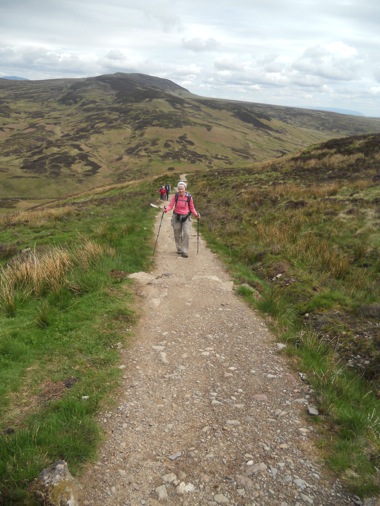 Nearing the top of Conic Hill. It's a steady climb of some 500 feet in about a mile. THe path, as you can see, is good rising steady above the moorlands.
Nearing the top of Conic Hill. It's a steady climb of some 500 feet in about a mile. THe path, as you can see, is good rising steady above the moorlands.  Here is a view of a typical Loch Lomond beach. It isn't quite as threatening as this picture might suggest but the sun never did appear today.
Here is a view of a typical Loch Lomond beach. It isn't quite as threatening as this picture might suggest but the sun never did appear today. I must have been doing something to give Mom a chance to relax on this bench. I think I was changing a battery. This was one of the few open areas we would pass through during the second half of the hike. Mostly we were in forest that was sometimes on the shoreline and sometimes, sadly, not.
I must have been doing something to give Mom a chance to relax on this bench. I think I was changing a battery. This was one of the few open areas we would pass through during the second half of the hike. Mostly we were in forest that was sometimes on the shoreline and sometimes, sadly, not.